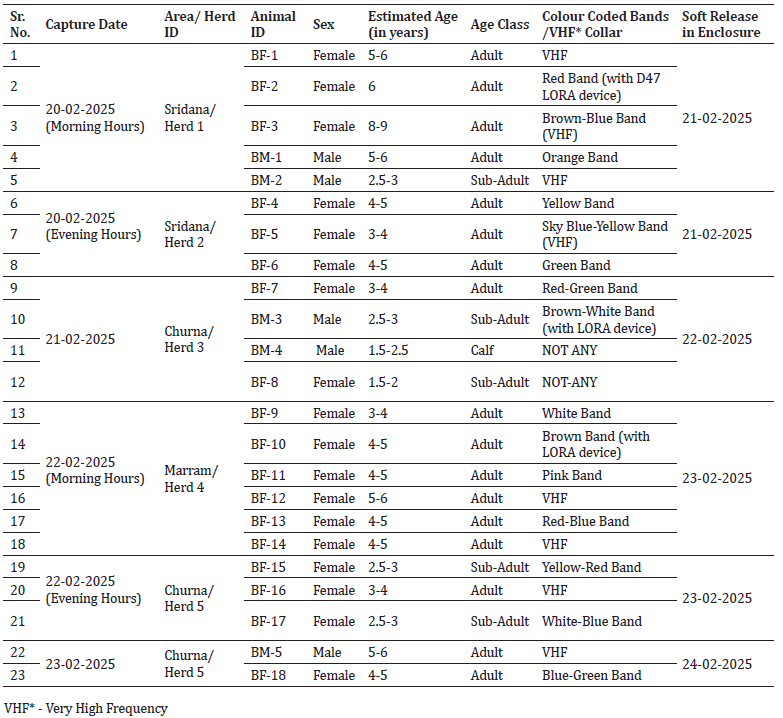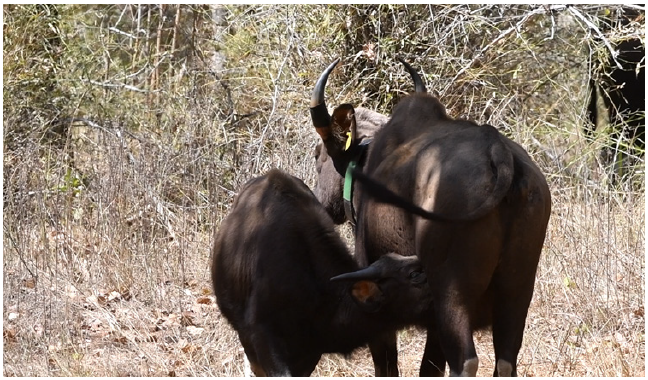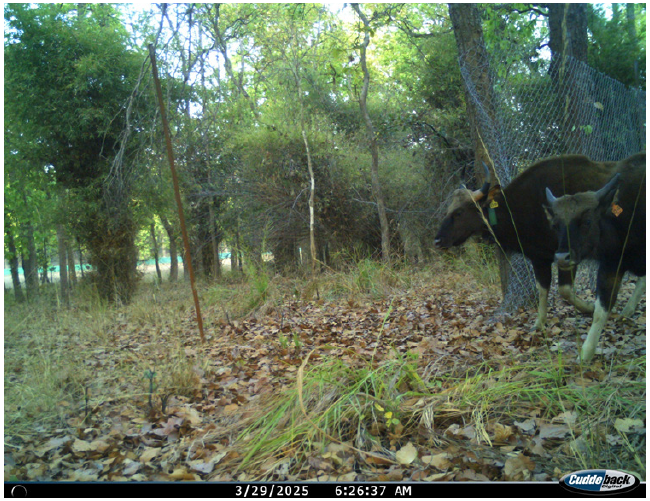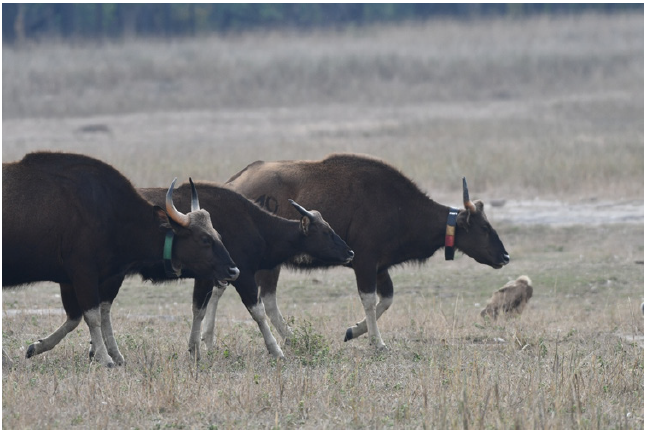TYPE: Natural History Note![]()
RECEIVED 02 July 2025
ACCEPTED 04 September 2025
ONLINE EARLY 25 September 2025
Abstract
Allonursing is the nursing of non-filial offspring by lactating females. It is a rare form of alloparental care and remains virtually undocumented in wild bovids. Here, we report the first photographic and video evidence of allonursing in gaur (Bos gaurus gaurus), Asia’s largest extant bovine, from Bandhavgarh Tiger Reserve, Madhya Pradesh, India. The behaviour was observed during soft release monitoring as part of an ongoing project on population management strategies for gaur through supplementation. A lactating female was observed nursing a non-filial male calf from a different natal herd within the soft release enclosure. This behaviour provides new insights into the social flexibility of gaur and has implications for understanding behavioural flexibility in conservation-driven translocation efforts.
Keywords: Allonursing, alloparental care, bovine, gaur, mega herbivore, supplementation.
Introduction
Maternal care in ungulates is generally uniparental and short-term, especially for wild species of Bovidae (Stead et al., 2019). Allonursing is a rare form of alloparental care in which a lactating female nurses a non-filial offspring. Alloparental care has been observed and documented across numerous taxa, including birds, rodents, primates, canids, carnivores, and megaherbivores (Mota-Rojas et al., 2021; Stead et al., 2019; Bădescu et al., 2016; Malyjurková et al., 2014; Lewis et al., 1997). While alloparental care is common in cooperative breeders, it is unprecedented among wild Bovidae, where maternal care is extremely uniparental (Orihuela et al., 2021). Though allosuckling has been described in water buffaloes, there has been no documentation of allonursing in wild bovids, particularly gaur, until now (Orihuela et al., 2024).
Gaur (Bos gaurus), the largest extant wild bovid, is a gregarious herbivore found across South and Southeast Asia (Duckworth et al., 2008). In India, the distribution of species spans over three regions: Northeast, South-western, and Central Indian landscapes (Ashokkumar et al., 2011). The species inhabits diverse habitats ranging from evergreen to thorn forests and from lowlands to elevations of up to 2800m above mean sea level (Sankar et al., 2013; Ashokkumar et al., 2010; Krishnan, 1972). Gaur lives in a matrilineal society with fluid group composition where male lives solitary or form bachelor groups and mixed herds (Qureshi et al., 2025; Duckworth et al., 2016; Ashokkumar et al., 2011).
After becoming locally extinct in Bandhavgarh Tiger Reserve, Madhya Pradesh, in 1998, 50 individuals of gaur were reintroduced to the landscape in 2011-12 (Sankar et al., 2013, Nigam et al., 2022). The reintroduction was carried out to restore a viable gaur population and ecosystem functions. Also, gaur is a valuable prey species for large carnivores such as tigers (Sankar et al., 2013). Over time, the translocated population showed a growth rate of 5.7% every three years (Nigam et al., 2022). However, a genetic bottleneck became evident, necessitating the supplementation of individuals from a new genetic pool to improve genetic variability and ensure long-term species survivability (Nigam et al., 2022). Consequently, 23 animals from different herds were translocated from Satpura Tiger Reserve, Madhya Pradesh, in February 2025. The animals were soft-released into an enclosure with ample space and time for acclimatization and social bonding. During monitoring, a unique case of allonursing was observed.
Native herd profile
A total of five herds were chosen for the capture and translocation of gaur from Satpura Tiger Reserve to Bandhavgarh Tiger Reserve, which included 18 females and 5 males (Table 1). Care was taken while selecting the individuals for capture, and efforts were made to avoid disrupting social bonds or introducing biases that could compromise the group integrity. An adult female gaur (ID: BF-7) and male calf (ID: BM-4), which were noticed staying together during the capture operation and identified as biological mother-calf, were captured together and translocated. After soft releasing the animal in the enclosure at Bandhavgarh Tiger Reserve, BF-7 was confirmed as a non-biological mother over a series of observations.
Table 1: Details of translocated gaur from Satpura Tiger Reserve to Bandhavgarh Tiger Reserve (Nigam et al., 2025).

Observation of Allonursing
On 8th March 2025, we observed a newly translocated male calf (ID: BM–4) at Bandhavgarh Tiger Reserve inside the soft-release enclosure, approaching and attempting to suckle from an adult female gaur (ID: BF–6). Both individuals were brought in from different wild herds, with BM–4 being brought on 21 February and BF–6 on 20 February 2025. There was no evidence of kinship between BM–4 and BF–6. Moreover, BF–6 neither avoided BM–4 nor displayed aggressive behavior. Instead, the female gaur (ID: BF-6) stood relaxed and allowed the calf (ID: BM-4) to suckle and groomed the calf (Figure 1).
Allonuring behavior was observed opportunistically for the next 23 days, until 30th March 2025, before the animal’s release into the wild. As the animals were not purposefully followed, no systematic study design was employed. During this period, BM–4 continually sought to suckle from BF–6, and BF–6 allowed the calf to suckle. The seemingly effortless and tolerating behavior by the female, along with grooming while suckling, suggested that an affiliative relationship formed between the female gaur and calf (Figure 1). Throughout the observation, neither individual appeared to show signs of rejection, defensive behaviors, or manifest distress.
The animals were identifiable with the full combination of ear tags, neck bands, and horn sleeve markers (Figure 2&3). As all translocated individuals came from various native herds, and the female BF–6 and the male calf BM–4 did not share any established biological relationship, this case was unequivocally confirmed as allonursing in gaur, a rarely observed phenomenon in social animals and a specific form of alloparental care (Mota-Rojas et al., 2021; Engelhardt et al., 2014).

Figure 1: A lactating female gaur nurses a non-filial calf

Figure 2: Camera trap picture of the female gaur with the non-filial calf

Figure 3: Calf with the non-biological female gaur after being released from the enclosure into the open forest
Discussion
The case of BM–4 and BF–6 is the first documented case of allonursing in free-ranging gaur. It highlights the social flexibility to develop some form of social bond between the species in a novel ecological and social context introduced through conservation translocation. The frequent presence of and prodromal opportunities of affiliation suggest some form of intent (Engelhardt et al., 2014; Mota-Rojas et al., 2021), unlike those cases of milk theft or mismothering.
Alloparental care has been observed and documented across numerous taxa (Guo et al., 2022; Mota-Rojas et al., 2021; Stead et al., 2019; Bădescu et al., 2016; Malyjurková et al., 2014; Lewis et al., 1997). Earlier studies have recorded alloparental care in some domestic and semi-wild species such as water buffalo (Orihuela et al., 2024) and reindeer (Engelhardt et al., 2014). In wild bovid species, the allonursing is virtually unrecorded. Several hypotheses have been proposed to explain why alloparental care occurs, some of which include misdirected maternal behavior, milk evacuation process, gaining maternity skills, kin selection, and reciprocal altruism (Engelhardt et al., 2016; Maniscalco et al., 2007). For calves, such behavior may be beneficial by providing immunological advantages and nutritional compensation (Orihuela et al., 2024; Mota-Rojas et al., 2021; Engelhardt et al., 2014; Brandlová et al., 2013).
As shown in domestic water buffalo (Bubalus bubalis), cooperative nursing has been observed in a high-density resource-limited context (Orihuela et al., 2024). We hypothesize that the socially dynamic and controlled space of the soft-release enclosure was the essential ecological cue that facilitated allonursing in this case. These semi-natural environments could promote other affiliative responses as species-specific adaptive responses to environmental stressors and social situations associated with their translocation.
In our study, the occurrence of allonursing in translocated gaur may be linked to: a) Mistaken direct maternal behavior, because of hormonal state (Maniscalco et al., 2007; Engelhardt et al., 2014), b) Formation and renegotiation of social bonds in a new social environment (Mota-Rojas et al., 2021; Orihuela et al., 2021), c) Potentially reciprocal altruism or other mechanisms of inclusive fitness, especially in systems where kin discrimination is weak (Hamilton, 1964; Engelhardt et al., 2016), or d) Social cohesion by virtue of stress, facilitated by proximity in an enclosure (Malyjurková et al., 2014).
Most importantly, the soft release of the male calf in the enclosure probably added to its survival. Maternal dependency of the calf could have made it vulnerable due to starvation and predation, especially by tigers. Therefore, demonstrating allonursing in this context is not only an indication of behavioral plasticity, but also a situational altruistic response. This incident also underlines the ecological significance of transitional enclosures. Such enclosures could promote species-appropriate social behaviors that induce fitness in new environmental conditions associated with conservation.
In the context of this finding, translocation-related stress, social restructuring, and affiliative bonding may have contributed to the emergence of allonursing behavior. The defined area of enclosure may have facilitated social restructuring that supported alloparental care. Remarkably, such behavior could specify adaptive social flexibility in gaur, particularly in response to novel environmental or social conditions.
Conservation implications
Understanding the alloparental behaviour in translocated animals has a significant role in refining conservation strategies. In species with complex social systems, behavioural plasticity, such as allonursing, could enhance calf survival in unfamiliar environments, especially when natal social bonds are disrupted. Further, given current observations on gaur and other similar findings on buffaloes, contexts that facilitate a series of affiliative interactions may help alleviate the stress of social instability. The documentation of allonursing in gaur highlights the significance of post-release monitoring to understand the complexity of behavioral traits. This report can help better inform translocation efforts and facilitate social integration of translocated individuals in a novel environment.
Acknowledgement
We appreciate the hard work put forth by the staff at the Bandhavgarh Tiger Reserve. We thank the Madhya Pradesh Forest Department for their positive attitude towards wildlife conservation.
ETHICAL STATEMENT
The work does not involve any animal handling or invasive sampling. Observations are carried out from the predesignated watchtowers and camera traps to minimize disturbance to wildlife.
CONFLICT OF INTEREST
Bilal Habib & Parag Nigam hold editorial positions at the Journal of Wildlife Science. However, they did not participate in the peer review process of this article except as authors. The authors declare no other conflict of interest.
DATA AVAILABILITY
The videography will be provided upon request from the corresponding author
AUTHORS’ CONTRIBUTION
GAK contributed in data collection; GAK, BB prepared the first draft; RV edited and refined the manuscript; PN, BH provided inputs on the draft.
Edited By
Sambandam Sathyakumar
Wildlife Institute of India, Dehradun.
*CORRESPONDENCE
Parag Nigam
✉ nigamp@wii.gov.in
CITATION
Gorati, A. K., Vishwakarma, R., Bhandari, B., Habib, B. & Nigam, P. (2025). First Evidence of Allonursing in Gaur (Bos gaurus gaurus): Social Flexibility in a Translocated Population. Journal of Wildlife Science, Online Early Publication, 01-04. https://doi.org/10.63033/JWLS.NQFE5213
FUNDING
Madhya Pradesh Forest Department
COPYRIGHT
© 2025 Gorati, Vishwakarma, Bhandari, Habib & Nigam. This is an open-access article, immediately and freely available to read, download, and share. The information contained in this article is dis¬tributed under the terms of the Creative Commons Attribution License (CC BY 4.0), allowing for unrestricted use, distribution, and reproduction in any medium, provided the original work is properly cited in accordance with accepted academic practice. Copyright is retained by the author(s).
PUBLISHED BY
Wildlife Institute of India, Dehradun, 248 001 INDIA
PUBLISHER'S NOTE
The Publisher, Journal of Wildlife Science or Editors cannot be held responsible for any errors or consequences arising from the use of the information contained in this article. All claims expressed in this article are solely those of the author(s) and do not necessarily represent those of their affiliated organisations or those of the publisher, the editors and the reviewers. Any product that may be evaluated or used in this article or claim made by its manufacturer is not guaranteed or endorsed by the publisher.
Ashokkumar, M., Nagarajan, R. & Desai, A. A. (2010). Gaur: Wild Cattle in Peril. Science Reporter, (November 2010), 33-35.
Ashokkumar, M., Swaminathan, S., Nagarajan, R. & Desai, A. A. (2011). Distribution, ecology and conservation of the Gaur (Bos Gaurus, H. Smith, 1824). Animal diversity, natural history and conservation, 1, 77-94.
Bădescu, I., Watts, D. P., Katzenberg, M. A. & Sellen, D. W. (2016). Alloparenting is associated with reduced maternal lactation effort and faster weaning in wild chimpanzees. Royal Society open science, 3(11), 160577. https://doi.org/10.1098/rsos.160577
Brandlova´, K., Bartosˇ, L. & Haberova´, T. (2013). Camel Calves as Opportunistic Milk Thefts? The First Description of Allosuckling in Domestic Bactrian Camel (Camelus bactrianus). PLoS ONE 8(1), e53052. https://doi.org/10.1371/journal.pone.0053052
Duckworth, J. W., Sankar, K., Williams, A. C., Samba Kumar, N. & Timmins, R. J. (2016). Bos gaurus. The IUCN Red List of Threatened Species, e. T2891A46363646. https://dx.doi.org/10.2305/IUCN.UK.2016-2.RLTS.T2891A46363646.en.
Duckworth, J. W., Steinmetz, R., Timmins, R. J., Pattanavibool, A., Than Zaw, Do Tuoc & Hedges, S. (2008). Bos gaurus. The IUCN Red List of Threatened Species, e.T2891A9491805. http://dx.doi.org/10.2305/IUCN.UK.2008.RLTS.T2891A9491805.en.
Engelhardt, S. C., Weladji, R. B., Holand, Ø., de Rioja, C. M., Ehmann, R. K. & Nieminen, M. (2014). Allosuckling in reindeer (Rangifer tarandus): Milk-theft, mismothering or kin selection?. Behavioural Processes, 107, 133–141. https://doi.org/10.1016/j.beproc.2014.08.013
Guo, Y., Grueter, C. C. & Lu, J. (2022). Allomaternal care and 'adoption' in an edge-of-range population of Taihangshan macaques in Northern China. Current Zoology, 69(2), 215-218. https://doi.org/10.1093/cz/zoac027
Hamilton, W. D. (1964). The genetical evolution of social behaviour. I & II. Journal of Theoretical Biology, 7(1), 1–52. https://doi.org/10.1016/0022-5193(64)90038-4
Krishnan, M. (1972). An ecological survey of the larger mammals of peninsular India. The Journal of the Bombay Natural History Society, 69, 26–54.
Lewis, S. E. & Pusey, A. E. (1997). Factors influencing the occurrence of communal care in plural breeding mammals. Cooperative breeding in mammals, 335-363. https://doi.org/10.1017/CBO9780511574634.013
Malyjurková, L., Hejzlarová, M., Vymyslická, P. J. & Brandlová, K. (2014). Social Preferences of Translocated Giraffes (Giraffa camelopardalis giraffa) in Senegal: Evidence for Friendship among Females?. Maternal Behaviour in Giraffes, 47(1), 92.
Maniscalco, J. M., Harris, K. R., Atkinson, S. & Parker, P. (2007). Alloparenting in Steller sea lions (Eumetopias jubatus): correlations with misdirected care and other observations. Journal of Ethology, 25, 125-131. https://doi.org/10.1007/s10164-006-0001-4
Mota-Rojas, D., Marcet-Rius, M., Freitas-de-Melo, A., Muns, R., Mora-Medina, P., Domínguez-Oliva, A. & Orihuela, A. (2021). Allonursing in Wild and Farm Animals: Biological and Physiological Foundations and Explanatory Hypotheses. Animals, 11(11), 3092. https://doi.org/10.3390/ani11113092
Nigam, P., Gorati, A. K., Vishwakarma, R., Bhandari, B., Habib, B., Mondol, S., Sen, S., Krishnamoorthy. L., Sahay, A., Nanda, R. & Tiwari, V. R. (2025). Supplementation of Gaur in Bandhavgarh Tiger Reserve, Madhya Pradesh–Technical Report. Wildlife Institute of India, Dehradun, India. (Tr. No./2025/10, Dated: 16/06/2025), p.60.
Nigam, P., Mondol, S., Habib, B., Vishwakarma, R., Nandwanshi, V.B., Bhati, R. & Annigeri, B. S. (2022). Monitoring Reintroduced Gaur (Bos gaurus) in Bandhavgarh Tiger Reserve, Madhya Pradesh, Phase II, Extension (2018-22) – Final Report, Wildlife Institute of India, Dehradun, India. (Tr. No.2022/23, p.119)
Orihuela, A., Bienboire-Frosini, C., Chay-Canul, A., Álvarez-Macías, A., Marcet-Rius, M., Domínguez-Oliva, A., Mora-Medina, P., Olmos-Hernández, A. & Napolitano, F. et al. (2024). Allonursing in water buffalo: Cooperative maternal behavior in domestic Bovidae. Journal of Animal Behaviour and Biometeorology, 12(3), 2024023. https://doi.org/10.31893/jabb.2024023
Orihuela, A., Pérez-Torres, L. I. & Ungerfeld, R. (2021). Evidence of cooperative calves’ care and providers’ characteristics in zebu cattle (Bos indicus) raised under extensive conditions. Tropical Animal Health and Production, 53, 1-6. https://doi.org/10.1007/s11250-020-02451-y
Qureshi, Q., Kolipakam, V., Jhala, V. Y., Kumar, U., Habib, B., Mathur, C, V., Mallick, A., Yadav, P. S., Bharadwaj, S. G. & Tiwari, R. V. (2025). Status of Ungulates in Tiger Habitats of India. National Tiger Conservation Authority, New Delhi, and Wildlife Institute of India, Dehradun.
Sankar, K., Pabla, H. S., Patil, C. K., Nigam, P., Qureshi, Q., Navaneethan, B., & Mondal, K. (2013). Home Range, Habitat Use and Food Habits of Re-Introduced Gaur (Bos Gaurus Gaurus) in Bandhavgarh Tiger Reserve, Central India. Tropical Conservation Science, 6(1), 50-69. https://doi.org/10.1177/194008291300600108
Stead, S., Mucha, S. & Bădescu, I. (2019). Alloparental Care. In: Vonk, J. & Shackelford, T. (eds.), Encyclopedia of Animal Cognition and Behavior. Cham, Switzerland. Springer, pp.1–7. https://doi.org/10.1007/978-3-319-47829-6_1400-1
Edited By
Sambandam Sathyakumar
Wildlife Institute of India, Dehradun.
*CORRESPONDENCE
Parag Nigam
✉ nigamp@wii.gov.in
CITATION
Gorati, A. K., Vishwakarma, R., Bhandari, B., Habib, B. & Nigam, P. (2025). First Evidence of Allonursing in Gaur (Bos gaurus gaurus): Social Flexibility in a Translocated Population. Journal of Wildlife Science, Online Early Publication, 01-04. https://doi.org/10.63033/JWLS.NQFE5213
FUNDING
Madhya Pradesh Forest Department
COPYRIGHT
© 2025 Gorati, Vishwakarma, Bhandari, Habib & Nigam. This is an open-access article, immediately and freely available to read, download, and share. The information contained in this article is dis¬tributed under the terms of the Creative Commons Attribution License (CC BY 4.0), allowing for unrestricted use, distribution, and reproduction in any medium, provided the original work is properly cited in accordance with accepted academic practice. Copyright is retained by the author(s).
PUBLISHED BY
Wildlife Institute of India, Dehradun, 248 001 INDIA
PUBLISHER'S NOTE
The Publisher, Journal of Wildlife Science or Editors cannot be held responsible for any errors or consequences arising from the use of the information contained in this article. All claims expressed in this article are solely those of the author(s) and do not necessarily represent those of their affiliated organisations or those of the publisher, the editors and the reviewers. Any product that may be evaluated or used in this article or claim made by its manufacturer is not guaranteed or endorsed by the publisher.
Ashokkumar, M., Nagarajan, R. & Desai, A. A. (2010). Gaur: Wild Cattle in Peril. Science Reporter, (November 2010), 33-35.
Ashokkumar, M., Swaminathan, S., Nagarajan, R. & Desai, A. A. (2011). Distribution, ecology and conservation of the Gaur (Bos Gaurus, H. Smith, 1824). Animal diversity, natural history and conservation, 1, 77-94.
Bădescu, I., Watts, D. P., Katzenberg, M. A. & Sellen, D. W. (2016). Alloparenting is associated with reduced maternal lactation effort and faster weaning in wild chimpanzees. Royal Society open science, 3(11), 160577. https://doi.org/10.1098/rsos.160577
Brandlova´, K., Bartosˇ, L. & Haberova´, T. (2013). Camel Calves as Opportunistic Milk Thefts? The First Description of Allosuckling in Domestic Bactrian Camel (Camelus bactrianus). PLoS ONE 8(1), e53052. https://doi.org/10.1371/journal.pone.0053052
Duckworth, J. W., Sankar, K., Williams, A. C., Samba Kumar, N. & Timmins, R. J. (2016). Bos gaurus. The IUCN Red List of Threatened Species, e. T2891A46363646. https://dx.doi.org/10.2305/IUCN.UK.2016-2.RLTS.T2891A46363646.en.
Duckworth, J. W., Steinmetz, R., Timmins, R. J., Pattanavibool, A., Than Zaw, Do Tuoc & Hedges, S. (2008). Bos gaurus. The IUCN Red List of Threatened Species, e.T2891A9491805. http://dx.doi.org/10.2305/IUCN.UK.2008.RLTS.T2891A9491805.en.
Engelhardt, S. C., Weladji, R. B., Holand, Ø., de Rioja, C. M., Ehmann, R. K. & Nieminen, M. (2014). Allosuckling in reindeer (Rangifer tarandus): Milk-theft, mismothering or kin selection?. Behavioural Processes, 107, 133–141. https://doi.org/10.1016/j.beproc.2014.08.013
Guo, Y., Grueter, C. C. & Lu, J. (2022). Allomaternal care and 'adoption' in an edge-of-range population of Taihangshan macaques in Northern China. Current Zoology, 69(2), 215-218. https://doi.org/10.1093/cz/zoac027
Hamilton, W. D. (1964). The genetical evolution of social behaviour. I & II. Journal of Theoretical Biology, 7(1), 1–52. https://doi.org/10.1016/0022-5193(64)90038-4
Krishnan, M. (1972). An ecological survey of the larger mammals of peninsular India. The Journal of the Bombay Natural History Society, 69, 26–54.
Lewis, S. E. & Pusey, A. E. (1997). Factors influencing the occurrence of communal care in plural breeding mammals. Cooperative breeding in mammals, 335-363. https://doi.org/10.1017/CBO9780511574634.013
Malyjurková, L., Hejzlarová, M., Vymyslická, P. J. & Brandlová, K. (2014). Social Preferences of Translocated Giraffes (Giraffa camelopardalis giraffa) in Senegal: Evidence for Friendship among Females?. Maternal Behaviour in Giraffes, 47(1), 92.
Maniscalco, J. M., Harris, K. R., Atkinson, S. & Parker, P. (2007). Alloparenting in Steller sea lions (Eumetopias jubatus): correlations with misdirected care and other observations. Journal of Ethology, 25, 125-131. https://doi.org/10.1007/s10164-006-0001-4
Mota-Rojas, D., Marcet-Rius, M., Freitas-de-Melo, A., Muns, R., Mora-Medina, P., Domínguez-Oliva, A. & Orihuela, A. (2021). Allonursing in Wild and Farm Animals: Biological and Physiological Foundations and Explanatory Hypotheses. Animals, 11(11), 3092. https://doi.org/10.3390/ani11113092
Nigam, P., Gorati, A. K., Vishwakarma, R., Bhandari, B., Habib, B., Mondol, S., Sen, S., Krishnamoorthy. L., Sahay, A., Nanda, R. & Tiwari, V. R. (2025). Supplementation of Gaur in Bandhavgarh Tiger Reserve, Madhya Pradesh–Technical Report. Wildlife Institute of India, Dehradun, India. (Tr. No./2025/10, Dated: 16/06/2025), p.60.
Nigam, P., Mondol, S., Habib, B., Vishwakarma, R., Nandwanshi, V.B., Bhati, R. & Annigeri, B. S. (2022). Monitoring Reintroduced Gaur (Bos gaurus) in Bandhavgarh Tiger Reserve, Madhya Pradesh, Phase II, Extension (2018-22) – Final Report, Wildlife Institute of India, Dehradun, India. (Tr. No.2022/23, p.119)
Orihuela, A., Bienboire-Frosini, C., Chay-Canul, A., Álvarez-Macías, A., Marcet-Rius, M., Domínguez-Oliva, A., Mora-Medina, P., Olmos-Hernández, A. & Napolitano, F. et al. (2024). Allonursing in water buffalo: Cooperative maternal behavior in domestic Bovidae. Journal of Animal Behaviour and Biometeorology, 12(3), 2024023. https://doi.org/10.31893/jabb.2024023
Orihuela, A., Pérez-Torres, L. I. & Ungerfeld, R. (2021). Evidence of cooperative calves’ care and providers’ characteristics in zebu cattle (Bos indicus) raised under extensive conditions. Tropical Animal Health and Production, 53, 1-6. https://doi.org/10.1007/s11250-020-02451-y
Qureshi, Q., Kolipakam, V., Jhala, V. Y., Kumar, U., Habib, B., Mathur, C, V., Mallick, A., Yadav, P. S., Bharadwaj, S. G. & Tiwari, R. V. (2025). Status of Ungulates in Tiger Habitats of India. National Tiger Conservation Authority, New Delhi, and Wildlife Institute of India, Dehradun.
Sankar, K., Pabla, H. S., Patil, C. K., Nigam, P., Qureshi, Q., Navaneethan, B., & Mondal, K. (2013). Home Range, Habitat Use and Food Habits of Re-Introduced Gaur (Bos Gaurus Gaurus) in Bandhavgarh Tiger Reserve, Central India. Tropical Conservation Science, 6(1), 50-69. https://doi.org/10.1177/194008291300600108
Stead, S., Mucha, S. & Bădescu, I. (2019). Alloparental Care. In: Vonk, J. & Shackelford, T. (eds.), Encyclopedia of Animal Cognition and Behavior. Cham, Switzerland. Springer, pp.1–7. https://doi.org/10.1007/978-3-319-47829-6_1400-1




